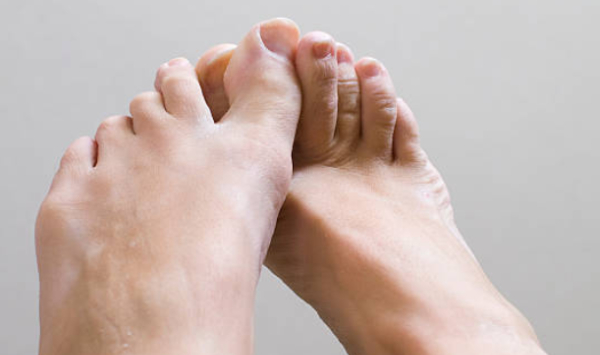Ringworm of the feet, tinea pedis, also known as chilblain or athlete's foot, is considered the most common ringworm in the world.
It can be said that 70% of the population will have ringworm in the feet at some point in their lives.
It usually presents more in males, regardless of racial or ethnic group.
Furthermore, we can say that the prevalence of tinea pedis increases with age, with the majority of cases occurring after puberty and rarely affecting the child population.
Tinea pedis is not associated with significant mortality or morbidity, although its prognosis can be affected when conditions of immunosuppression and diabetes are associated.
As tinea pedis is very uncomfortable, the sooner your problem is diagnosed, the faster the treatment and the end of the discomfort will be.
This article will help you understand this problem and how to treat it. We'll talk about:
- What is ringworm of the feet?
- Clinical forms of foot mycoses: intertriginous or athlete's foot, vesicular, scaly and ulcerated
- Diagnosis of mycosis of the feet
- Treatment of ringworm of the feet
- Healthy habits and prevention of foot ringworm
If you want to know more about ringworm, you can also read the article on nail ringworm: How to know if I have ringworm
1. What is ringworm of the feet?
Ringworm of the feet or tinea pedis is a fungal infection of the soles and spaces between the toes (interdigital spaces) of the feet.
It is caused by fungi called dermatophytes, which are able to use keratin as a food source. Keratin is a protein that is present in the skin, hair and nails.
Fungi proliferate more easily in hot, humid places and in organisms with reduced immunity.
Ringworm of the feet is more frequent in athletes (especially swimmers), soldiers, sailors and students, where sweating, maceration, prolonged walking, tight shoes and poor hygiene facilitate fungal infection.
The infection can affect one or both feet and can spread to the nails, which become thick and brittle. Learn more about toenail fungus in the article: How to know if I have toenail fungus.
Ringworm of the feet is contagious and can be transmitted by contact with an infected person or by contact with contaminated surfaces such as towels, floors and shoes.
The spaces between the toes are the regions where fungi most often settle and start the infection process.
2. Clinical forms of foot mycoses
Clinically, ringworm of the feet can present itself in four ways:
image
a) Intertriginous Form or Athlete's Foot
The intertriginous form is the most common form of ringworm in the feet. It has this name because it occurs in skin fold regions, such as the spaces between the fingers, which provide more frequent friction and are hot and humid regions.
The site becomes reddish (with erythema), presenting maceration, fissure and scaling, occurring more frequently in the space between the fourth and fifth fingers.
This form is usually accompanied by itching, and a foul odor exhaled from the infection site is also observed.
image
b) Vesicular Form
The vesicular form is an acute form of ringworm of the feet, presents with vesicles and blisters that cause itching and irritation, and are painful.
They usually appear in the plantar region and eliminate yellowish liquid (citrus) when pierced, giving rise to persistent desquamation.
It is usually accompanied by an associated bacterial infection.
image
c) Hyperkeratotic or scaly form
The scaly form of mycosis of the feet is chronic and is characterized by scaly lesions with thick skin (hyperkeratosis) and, in more intense conditions, painful fissures.
Often located on both feet, plantar regions or lateral edges.
image
d) Ulcerated form
The ulcerated form is associated with the rapid spread of blisters with fluid inside and wounds (vesicular-pustular lesions, ulcers and erosions).
This form is often associated with secondary bacterial infection, usually in immunocompromised and diabetic patients.
3. Diagnosis of mycosis of the feet
Before starting any treatment, it is essential to identify the cause of the problem to indicate the right treatment for you.
Diagnosis of ringworm of the feet is usually based on the patient's symptoms and clinical appearance. However, there are other dermatoses clinically similar to mycosis on the feet, such as contact dermatitis, allergies, psoriasis, among others.
Therefore, a mycological examination is necessary, which consists of a scraping of the infected plantar and interdigital scales, for direct microscopic examination and for the culture, which will identify the responsible fungus and the specific medication to fight it.
A correct diagnosis will make the treatment more assertive, allowing you to have your problem solved more quickly and efficiently.
4. Treatment of ringworm of the feet
Ringworm of the feet can be treated with topical or oral antifungals or a combination of both. Only a doctor can prescribe the most suitable medication for your case, as well as the correct dosage and duration of treatment.
In general, patients with interdigital mycoses (athlete's foot or chilblains) can be treated with a topical antifungal. When this medication does not have the desired effect, it should be changed by the doctor, for an oral one.
Patients with vesicular or ulcerated ringworm or persistent tinea pedis may require oral antifungal treatment.
If you have foot sores that do not get better within a few weeks, see a doctor, especially if you are a diabetic.
5. Healthy habits and prevention of foot ringworm
Read some tips to fight ringworm of the feet:
a) Avoid going barefoot. Wear flip flops or sandals in public restrooms and pool feet washes.
b) Keep your feet clean and dry. Care must be taken to dry the feet well, especially between the toes.
c) Wearing clean cotton socks is important to reduce foot moisture. Change them daily.
d) Avoid using the same shoes daily, put them in the sun and/or treat them with antifungal powders before using them again.
e) Give preference to open shoes, the hot and humid environment of closed shoes is ideal for the proliferation of fungi.
In addition to medication, it is important to follow guidelines on healthy habits and prevention, in order to avoid re-infection of the ringworm or the creation of favorable environments for the proliferation of fungi.
So, put an end to the discomfort caused by ringworm of the feet, following our tips and if symptoms persist seek a doctor, take the mycological exam and know exactly what you need to fight to solve your problem.






